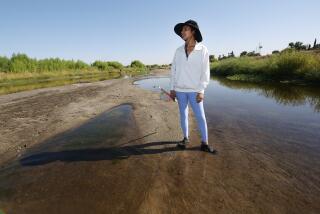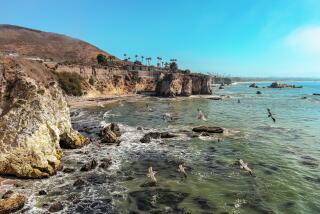Suit Opposing Dredging of Lagoon Rejected
- Share via
A Vista Superior Court judge swept aside a lawsuit by two environmental organizations Tuesday, opening the way for a controversial plan to dredge the sensitive Batiquitos Lagoon.
In a ruling by telephone, Judge Thomas R. Murphy ruled against the Sierra Club and the local chapter of the Audubon Society in their bid to block the dredging of the 2 1/2-mile-long, half-mile-wide strip of environmentally sensitive wetlands.
The controversial plan, backed by the California Coastal Commission, the city of Carlsbad and the Port of Los Angeles, would dredge 2.2 million to 3.1 million cubic yards of material to let ocean tides flush out the stagnating 600-acre lagoon.
The attorney for the Sierra Club, Laurens Silver, said the ruling did not surprise him and quickly announced that an appeal would be filed with the 4th District Court of Appeal.
“It seems to me that we are more likely to prevail in an upper court,” Silver said. “There have been some novel points of law raised in this case.”
Specifically, Silver said the courts have yet to rule on “what constitutes a ‘significant disturbance’ of wildlife habitat” that is prohibited by state law.
Despite the threat of an appeal, Dwight Worden, who represented the city of Carlsbad, said final designs for the project will continue, with actual dredging beginning within the next year.
“This project is really different. This is not developers building condos or even the government building a road through some habitat,” Worden said.
Worden contends that the “very best environmental experts in the business” have signed off on the project, which has received all the permits necessary to proceed.
The lawsuit represents the last legal hurdle to the eight-year struggle to restore the lagoon, Worden said.
Experts on both sides of the issue fear that over the next 40 to 50 years, rainwater runoff into the lagoon will deposit unwanted sediment and destroy Batiquitos Lagoon, one of the most important wetland bird habitats in the state, turning it into an upland vegetation site.
The Sierra Club and the Audubon Society agree that the lagoon needs more water, but argue that the dredging plan would make the water too deep and reduce the lagoon’s nesting area for birds, particularly the California least tern and the Belding’s savannah sparrow, both of which are endangered species.
They also say that the dredging project is being driven by the Port of Los Angeles, which needs to restore a deep-water wetlands area in exchange for being allowed to destroy similar habitats in the San Pedro area for future port expansions.
The port has offered to pay the estimated $30-million cost of the dredging plan.
The environmental organizations also say that developers backing the dredging plan are only interested in assuring that houses overlooking the lagoon have a water view.
“The developers in that area don’t give a fig about the environment, they only care about the views of those pretentious houses,” said Joan Jackson, chair of the Sierra Club’s national coastal issues committee.
“This project is really tampering with nature to an extent that is unprecedented,” Jackson said.
But Worden argues that the dredging proposal would bring a balanced habitat to the area, and accused the Sierra Club and the Audubon Society of being “narrow-minded” by ignoring the needs of marine life--the dredging is expected to make the lagoon a habitat for fish--in favor of those of birds.
“The Sierra Club is interested in the bird habitat and the bird habitat only. What the Coastal Commission and the other environmental organizations are interested in is restoring that lagoon to its natural historical condition. . . . It was a fish habitat, and a shellfish habitat and a bird habitat,” Worden said.
The lagoon is one of 19 high-priority wetlands designated by the state Department of Fish and Game. In 1984, the Coastal Conservancy, the agency charged with protecting the state’s coastal resources, began studying the lagoon’s preservation.
More to Read
Sign up for Essential California
The most important California stories and recommendations in your inbox every morning.
You may occasionally receive promotional content from the Los Angeles Times.










